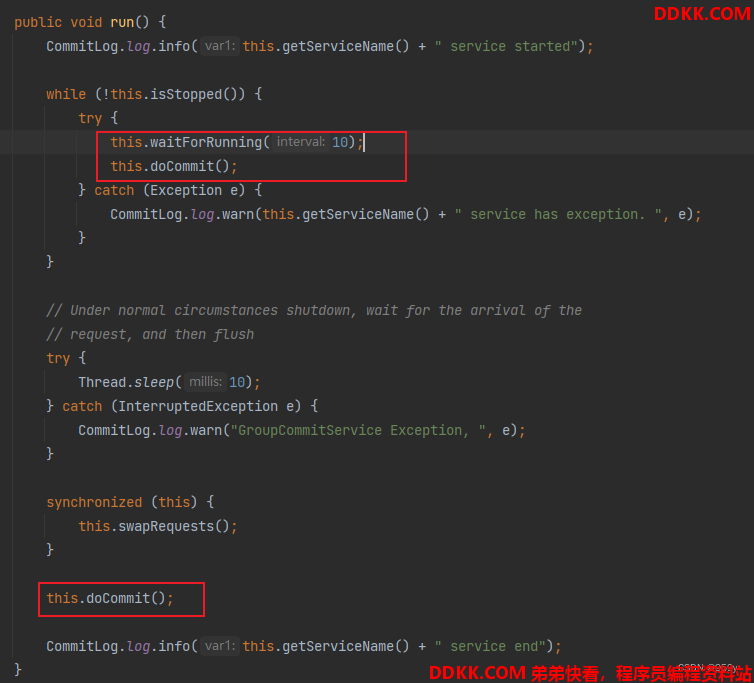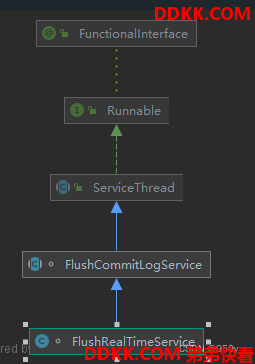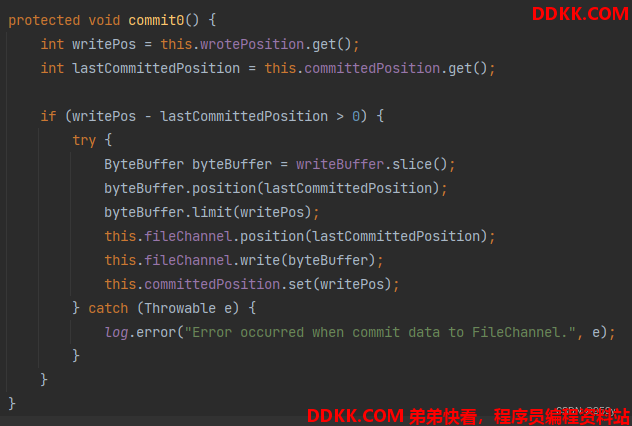1、 同步刷盘:在消息真正持久化至磁盘后RocketMQ的Broker端才会真正返回给Producer端一个成功的ACK响应;
2、 异常刷盘:能够充分利用OS的PageCache的优势,只要消息写入PageCache即可将成功的ACK返回给Producer端消息刷盘采用后台异步线程提交的方式进行,降低了读写延迟和提高了MQ性能和吞吐量;
- CommitLog#asyncPutMessage方法中会进行消息的存储, appendMessage仅仅是将消息追加到内存中, 没有在磁盘上。
- CommitLog#asyncPutMessage方法的最后才会调用submitFlushRequest方法提交刷盘请求, broker将会根据刷盘策略进行刷盘。该方法就是RocketMQ的broker刷盘的入口方法。
1.初始化存储服务
CommitLog初始化的时候, 会初始化存储服务。
1、 GroupCommitService:同步刷盘服务;
2、 FlushRealTimeService:异步刷盘服务;
3、 CommitRealTimeService:异常转存服务;

//CommitLog的构造器
if (FlushDiskType.SYNC_FLUSH == defaultMessageStore.getMessageStoreConfig().getFlushDiskType()) {
//如果是同步刷盘,则初始化GroupCommitService服务
this.flushCommitLogService = new GroupCommitService();
} else {
//如果是异步刷盘,则初始化GroupCommitService服务
this.flushCommitLogService = new FlushRealTimeService();
}
//异步转存数据服务:将堆外内存的数据提交到fileChannel
this.commitLogService = new CommitRealTimeService();
CommitLog#start()启动这些线程服务。
2.submitFlushRequest提交刷盘请求
CommitLog#asyncPutMessage()

根据broker的配置选择不同的刷盘策略:
1、 同步刷盘,为GroupCommitService服务;
1、 同步等待:如果消息的配置需要等待存储完成后才返回,那么构建同步刷盘请求,将请求存入内部的requestsWrite,并唤醒同步刷盘线程,返回future,没有填充刷盘的结果,在外部的thenCombine方法阻塞;
2、 同步不等待:消息的配置不需要等待存储完成后才返回,唤醒同步刷盘线程,返回PUT_OK;
2、 异步刷盘:;
1、 启动了堆外缓存读写分离,transientStorePoolEnable为true和不是slave,那么唤醒CommitRealTimeService服务;
2、 没有启动,唤醒FlushRealTimeService服务;

/**
* CommitLog的方法
* <p>
* 提交刷盘请求
*/
public CompletableFuture<PutMessageStatus> submitFlushRequest(AppendMessageResult result, MessageExt messageExt) {
// Synchronization flush
/*
* 同步刷盘策略
*/
if (FlushDiskType.SYNC_FLUSH == this.defaultMessageStore.getMessageStoreConfig().getFlushDiskType()) {
//获取同步刷盘服务GroupCommitService
final GroupCommitService service = (GroupCommitService) this.flushCommitLogService;
//判断消息的配置是否需要等待存储完成后才返回
if (messageExt.isWaitStoreMsgOK()) {
//同步刷盘并且需要等待刷刷盘结果
//构建同步刷盘请求 刷盘偏移量nextOffset = 当前写入偏移量 + 当前消息写入大小
GroupCommitRequest request = new GroupCommitRequest(result.getWroteOffset() + result.getWroteBytes(),
this.defaultMessageStore.getMessageStoreConfig().getSyncFlushTimeout());
//将请求加入到刷盘监视器内部的commitRequests中
flushDiskWatcher.add(request);
//将请求存入内部的requestsWrite,并且唤醒同步刷盘线程
service.putRequest(request);
//仅仅返回future,没有填充结果
return request.future();
} else {
//同步刷盘但是不需要等待刷盘结果,那么唤醒同步刷盘线程,随后直接返回PUT_OK
service.wakeup();
return CompletableFuture.completedFuture(PutMessageStatus.PUT_OK);
}
}
// Asynchronous flush
/*
* 异步刷盘策略
*/
else {
//是否启动了堆外缓存
if (!this.defaultMessageStore.getMessageStoreConfig().isTransientStorePoolEnable()) {
//如果没有启动了堆外缓存,那么唤醒异步刷盘服务FlushRealTimeService
flushCommitLogService.wakeup();
} else {
//如果启动了堆外缓存,那么唤醒异步转存服务CommitRealTimeService
commitLogService.wakeup();
}
return CompletableFuture.completedFuture(PutMessageStatus.PUT_OK);
}
}
3.GroupCommitService同步刷盘
- 创建GroupCommitService对象时, 会初始化两个内部集合, 为requestsWrite和requestsRead, requestsWrite用于存放putRequest方法写入的刷盘请求, requestsRead用于存放doCommit方法读取的刷盘请求。两个队列实现读写分离, 可以避免putRequest提交刷盘请求与doCommit消费刷盘请求之间的锁竞争。还会初始化一个独占锁, 用于保证存放请求和交换请求操作的线程安全。
//存放putRequest方法写入的刷盘请求
private volatile LinkedList<GroupCommitRequest> requestsWrite = new LinkedList<GroupCommitRequest>();
//存放doCommit方法读取的刷盘请求
private volatile LinkedList<GroupCommitRequest> requestsRead = new LinkedList<GroupCommitRequest>();
//同步服务锁
private final PutMessageSpinLock lock = new PutMessageSpinLock();
3.1 run同步刷盘

- 在死循环中不断的执行刷盘的操作
1、 waitForRunning,等待执行刷盘操作并且交换请求,同步刷盘服务最多等待10ms;
2、 doCommit,尝试执行批量刷盘;
/**
* GroupCommitService的方法
*/
public void run() {
CommitLog.log.info(this.getServiceName() + " service started");
/*
* 运行时逻辑
* 如果服务没有停止,则在死循环中执行刷盘的操作
*/
while (!this.isStopped()) {
try {
//等待执行刷盘,固定最多每10ms执行一次
this.waitForRunning(10);
//尝试执行批量刷盘
this.doCommit();
} catch (Exception e) {
CommitLog.log.warn(this.getServiceName() + " service has exception. ", e);
}
}
// Under normal circumstances shutdown, wait for the arrival of the
// request, and then flush
/*
* 停止时逻辑
* 在正常情况下服务关闭时,将会线程等待10ms等待请求到达,然后一次性将剩余的request进行刷盘。
*/
try {
Thread.sleep(10);
} catch (InterruptedException e) {
CommitLog.log.warn(this.getServiceName() + " Exception, ", e);
}
synchronized (this) {
this.swapRequests();
}
this.doCommit();
CommitLog.log.info(this.getServiceName() + " service end");
}
3.1.1 waitForRunning等待运行#
刷盘线程等待执行刷盘操作并且交换请求, 该方法是父类ServiceThread的方法, 同步和异步刷盘服务都会调用该方法, 同步刷盘服务最多等待10s。

1、 首先尝试尝试CAS的将已通知标志位从true改为false,表示正在或已执行刷盘操作,如果成功则表示服务线程曾被尝试唤醒过,或者说wakeup()方法曾被调用过,即此前曾有过消息存储的请求,那么此时直接调用onWaitEnd方法交换读写队列,为后续消息持久化做准备;
2、 如果CAS失败,即已通知标志位已经是false了,表示服务线程曾没有被尝试唤醒过,或者说wakeup()方法曾没有被调用过,即此前这段时间没有提交过消息存储的请求;
3、 由于此前没有刷盘请求被提交过,那么刷盘服务线程等待一定的时间,减少资源消耗,等待的时间有参数传递,同步刷盘服务最多等待10ms;
4、 等待时间到了或者因为刷盘请求而被唤醒,此时将已通知标志位直接改为false,表示正在或已执行刷盘操作调用onWaitEnd方法交换读写队列,为后续消息持久化做准备,一定会刷盘一次;
- CAS成功则表示此前有过提交请求, 则交换读写队列并结束, 失败则等待, 直到超时或者被提交请求唤醒。
- 同步刷盘服务在没有提交请求的时候同样会等待, 最多为10s。
/**
* ServiceThread的方法
* <p>
* 等待执行刷盘,同步和异步刷盘服务都会调用该方法
*
* @param interval 时间
*/
protected void waitForRunning(long interval) {
//尝试CAS的将已通知标志位从true改为false,表示正在或已执行刷盘操作
if (hasNotified.compareAndSet(true, false)) {
//如果成功则表示服务线程曾被尝试唤醒过,或者说wakeup()方法曾被调用过,即此前曾有过消息存储的请求
//那么此时直接调用onWaitEnd方法交换读写队列,为后续消息持久化做准备
this.onWaitEnd();
return;
}
/*
* 进入这里表示CAS失败,即已通知标志位已经是false了
* 表示服务线程曾没有被尝试唤醒过,或者说wakeup()方法曾没有被调用过,即此前这段时间没有提交过消息存储的请求
*/
//entry to wait
//重置倒计数
waitPoint.reset();
try {
//由于此前没有刷盘请求被提交过,那么刷盘服务线程等待一定的时间,减少资源消耗
//同步刷盘服务最多等待10ms
waitPoint.await(interval, TimeUnit.MILLISECONDS);
} catch (InterruptedException e) {
log.error("Interrupted", e);
} finally {
//等待时间到了或者因为刷盘请求而被唤醒,此时将已通知标志位直接改为false,表示正在或已执行刷盘操作
hasNotified.set(false);
//调用onWaitEnd方法交换读写队列,为后续消息持久化做准备,一定会尝试执行一次刷盘操作
this.onWaitEnd();
}
}
onWaitEnd等待结束交换请求: GroupCommitService服务重写, 用于交换读写队列。
/**
* GroupCommitService交换读写队列
*/
@Override
protected void onWaitEnd() {
//交换请求: 交换读写队列引用, 交换的时候需要加锁
this.swapRequests();
}
/**
* GroupCommitService的方法
* 交换请求
*/
private void swapRequests() {
//加锁
lock.lock();
try {
//交换读写队列
LinkedList<GroupCommitRequest> tmp = this.requestsWrite;
//requestsRead是一个空队列
this.requestsWrite = this.requestsRead;
this.requestsRead = tmp;
} finally {
lock.unlock();
}
}
3.1.2. doCommit执行刷盘#
requestsRead实际上引用到了requestsWrite队列, doCommit方法将会执行刷盘操作。
1、 判断requestsRead队列是否存在元素,如果不存在,刷盘操作因为某些消息的设置是同步刷盘但是不等待,因此这里直接调用mappedFileQueue.flush(0)方法进行一次同步刷盘即可,无需唤醒线程;
2、 如果队列存在元素,表示有提交同步等待刷盘请求,遍历队列,依次刷盘操作;
1、 每个刷盘请求最多刷盘两次;
1. 判断如果flushedWhere
3、 刷盘结束后,将会修改StoreCheckpoint中的physicMsgTimestamp,最新commitlog文件的刷盘时间戳,用于重启数据恢复;
4、 最后为requestsRead重新创建一个空的队列当下一次交换队列的时候,requestsWrite又会成为一个空队列;
/**
* GroupCommitService的方法
* 执行同步刷盘操作
*/
private void doCommit() {
//如果requestsRead读队列不为空,表示有提交请求,那么全部刷盘
if (!this.requestsRead.isEmpty()) {
//遍历所有的刷盘请求
for (GroupCommitRequest req : this.requestsRead) {
// There may be a message in the next file, so a maximum of
// two times the flush
//一个同步刷盘请求最多进行两次刷盘操作,因为文件是固定大小的,第一次刷盘时可能出现上一个文件剩余大小不足的情况
//消息只能再一次刷到下一个文件中,因此最多会出现两次刷盘的情况
//如果flushedWhere大于下一个刷盘点位,则表示该位置的数据已经刷刷盘成功了,不再需要刷盘
//flushedWhere的CommitLog的整体已刷盘物理偏移量
boolean flushOK = CommitLog.this.mappedFileQueue.getFlushedWhere() >= req.getNextOffset();
//最多循环刷盘两次
for (int i = 0; i < 2 && !flushOK; i++) {
/*
* 执行强制刷盘操作,最少刷0页,即所有消息都会刷盘
*/
CommitLog.this.mappedFileQueue.flush(0);
//判断是否刷盘成功,如果上一个文件剩余大小不足,则flushedWhere会小于nextOffset,那么海选哦再刷一次
flushOK = CommitLog.this.mappedFileQueue.getFlushedWhere() >= req.getNextOffset();
}
//内部调用flushOKFuture.complete方法存入结果,将唤醒因为提交同步刷盘请求而被阻塞的线程
req.wakeupCustomer(flushOK ? PutMessageStatus.PUT_OK : PutMessageStatus.FLUSH_DISK_TIMEOUT);
}
//获取存储时间戳
long storeTimestamp = CommitLog.this.mappedFileQueue.getStoreTimestamp();
//修改StoreCheckpoint中的physicMsgTimestamp:最新commitlog文件的刷盘时间戳,单位毫秒
//这里用于重启数据恢复
if (storeTimestamp > 0) {
CommitLog.this.defaultMessageStore.getStoreCheckpoint().setPhysicMsgTimestamp(storeTimestamp);
}
//requestsRead重新创建一个空的队列,当下一次交换队列的时候,requestsWrite又会成为一个空队列
this.requestsRead = new LinkedList<>();
} else {
// Because of individual messages is set to not sync flush, it
// will come to this process
//某些消息的设置是同步刷盘但是不等待,因此这里直接进行刷盘即可,无需唤醒线程等操作
CommitLog.this.mappedFileQueue.flush(0);
}
}
3.2 putRequest存入请求

调用该方法将加锁并将刷盘请求存入requestsWrite集合, 调用wakeup方法唤醒同步刷盘线程。
/**
* GroupCommitService的方法
*
* 加锁存入requestsWrite
* @param request
*/
public synchronized void putRequest(final GroupCommitRequest request) {
//获取锁
lock.lock();
try {
//存入
this.requestsWrite.add(request);
} finally {
lock.unlock();
}
//唤醒同步刷盘线程
this.wakeup();
}
3.2.1 wakeup唤醒刷盘线程#
wakeup方法尝试唤醒同步刷盘线程, 表示有新的同步等待刷盘请求被提交。
/**
* ServiceThread的方法
* 尝试唤醒等待的线程
*/
public void wakeup() {
//尝试CAS的将已通知标志位从false改为true
if (hasNotified.compareAndSet(false, true)) {
//如果成功则通知刷盘服务线程,如果失败则表示此前已经通知过了
waitPoint.countDown(); // notify
}
}
3.3 双队列读写分离设计
- 同步刷盘中, 两个队列requestsWrite和requestsRead, requestsWrite用于存放putRequest方法写入的刷盘请求, requestsRead用于存放doCommit方法读取的刷盘请求。
- 同步刷盘请求会首先调用putRequest方法存入requestsWrite队列中, 同步刷盘服务会最多每隔10ms就会调用swapRequests方法进行读写队列引用的交换, requestsWrite和requestsRead指针改变。并且putRequest方法和swapRequests方法会竞争同一把锁。
- 在swapRequests方法之后的doCommit刷盘方法中, 只会获取requestsRead中的刷盘请求进行刷盘, 在刷盘的最后会将requestsRead队列重新构建一个空队列, 而此过程中的刷盘请求都被提交到requestsWrite。
- 调用一次doCommit刷盘方法, 可以进行多个请求的批量刷盘。这里使用两个队列实现读写分离, 以及重置队列操作, 可以使得putRequest方法提交刷盘请求与doCommit方法消费刷盘请求同时进行, 避免了他们的锁竞争。
4.FlushRealTimeService异步刷盘
异步刷盘服务为FlushRealTimeService, 是一个线程任务。

4.1 run异步刷盘
死循环中不断的执行刷盘的操作。
1、 获取一系列参数;
1、 是否是定时刷盘,默认是false,不开启,通过flushCommitLogTimed配置;
2、 获取刷盘间隔时间,默认是500ms,通过flushIntervalCommitLog配置;
3、 获取刷盘最少页数,默认为4,通过flushCommitLogLeastPages配置;
4、 最长刷盘延迟间隔时间,默认10s,通过flushCommitLogThoroughInterval配置;
2、 如果当前时间距离上次刷盘时间大于等于10s,刷盘,因此设置刷盘的最少页数为0,更新刷盘时间戳为当前时间;
3、 判断是否是定时刷盘,如果是,那么当前线程sleep睡眠指定的间隔时间,否则那么调用waitForRunning方法,但可以被中途的wakeup方法唤醒进而直接尝试进行刷盘;
4、 线程醒来后调用mappedFileQueue.flush方法刷盘,指定最少页数,随后更新最新commitlog文件的刷盘时间戳,用于启动恢复;
5、 当刷盘服务被关闭时,默认执行10次刷盘操作,让消息少丢失;
/**
* FlushRealTimeService的方法
*/
public void run() {
CommitLog.log.info(this.getServiceName() + " service started");
/*
* 运行时逻辑
* 如果服务没有停止,则在死循环中执行刷盘的操作
*/
while (!this.isStopped()) {
//是否是定时刷盘,默认是false,即不开启
boolean flushCommitLogTimed = CommitLog.this.defaultMessageStore.getMessageStoreConfig().isFlushCommitLogTimed();
//获取刷盘间隔时间,默认500ms,可通过flushIntervalCommitLog配置
int interval = CommitLog.this.defaultMessageStore.getMessageStoreConfig().getFlushIntervalCommitLog();
//获取刷盘的最少页数,默认4,即16k,可通过flushCommitLogLeastPages配置
int flushPhysicQueueLeastPages = CommitLog.this.defaultMessageStore.getMessageStoreConfig().getFlushCommitLogLeastPages();
//最长刷盘延迟间隔时间,默认10s,可通过flushCommitLogThoroughInterval配置,即距离上一次刷盘超过10S时,不管页数是否超过4,都会刷盘
int flushPhysicQueueThoroughInterval =
CommitLog.this.defaultMessageStore.getMessageStoreConfig().getFlushCommitLogThoroughInterval();
boolean printFlushProgress = false;
// Print flush progress
long currentTimeMillis = System.currentTimeMillis();
//如果当前时间距离上次刷盘时间大于等于10s,那么必定刷盘
if (currentTimeMillis >= (this.lastFlushTimestamp + flushPhysicQueueThoroughInterval)) {
//更新刷盘时间戳为当前时间
this.lastFlushTimestamp = currentTimeMillis;
//最少刷盘页数为0,即不管页数是否超过4,都会刷盘
flushPhysicQueueLeastPages = 0;
printFlushProgress = (printTimes++ % 10) == 0;
}
try {
//判断是否是定时刷盘
if (flushCommitLogTimed) {
//如果定时刷盘,那么当前线程睡眠指定的间隔时间
Thread.sleep(interval);
} else {
//如果不是定时刷盘,那么调用waitForRunning方法,线程最多睡眠500ms
//可以被中途的wakeup方法唤醒进而直接尝试进行刷盘
this.waitForRunning(interval);
}
if (printFlushProgress) {
this.printFlushProgress();
}
/*
* 开始刷盘
*/
long begin = System.currentTimeMillis();
/*
* 刷盘指定的页数
*/
CommitLog.this.mappedFileQueue.flush(flushPhysicQueueLeastPages);
//获取存储时间戳
long storeTimestamp = CommitLog.this.mappedFileQueue.getStoreTimestamp();
//修改StoreCheckpoint中的physicMsgTimestamp:最新commitlog文件的刷盘时间戳,单位毫秒
//这里用于重启数据恢复
if (storeTimestamp > 0) {
CommitLog.this.defaultMessageStore.getStoreCheckpoint().setPhysicMsgTimestamp(storeTimestamp);
}
//刷盘消耗时间
long past = System.currentTimeMillis() - begin;
if (past > 500) {
log.info("Flush data to disk costs {} ms", past);
}
} catch (Throwable e) {
CommitLog.log.warn(this.getServiceName() + " service has exception. ", e);
this.printFlushProgress();
}
}
// Normal shutdown, to ensure that all the flush before exit
/*
* 停止时逻辑
* 在正常情况下服务关闭时,一次性执行10次刷盘操作
*/
boolean result = false;
for (int i = 0; i < RETRY_TIMES_OVER && !result; i++) {
result = CommitLog.this.mappedFileQueue.flush(0);
CommitLog.log.info(this.getServiceName() + " service shutdown, retry " + (i + 1) + " times " + (result ? "OK" : "Not OK"));
}
this.printFlushProgress();
CommitLog.log.info(this.getServiceName() + " service end");
}
- 异步刷盘下, 默认最少需要4页的脏数据才会刷盘, 另外还可以配置定时刷盘策略, 默认500ms, 且最长刷盘延迟间隔时间, 默认为10s。这些配置可以使得RocketMQ高可用, 但是消息丢失可能变大。
5.CommitRealTimeService异步堆外缓存刷盘
异步堆外缓存刷盘服务为CommitRealTimeService。

5.1 run异步堆外缓存刷盘
死循环中不断的执行刷盘的操作。
1、 获取一系列的配置参数;
1、 获取刷盘间隔时间,默认为200ms,通过commitIntervalCommitLog配置;
2、 获取刷盘的最少页数,默认为4,通过commitCommitLogLeastPages配置;
3、 获取刷盘延迟间隔时间,默认为200ms,通过commitCommitLogThoroughInterval配置;
2、 如果当前时间距离上次刷盘时间大于等于200ms,必然刷盘,因此设置刷盘的最少页数为0,更新刷盘时间戳为当前时间;
3、 调用mappedFileQueue.commit方法提交数据到fileChannel,而不是直接flush,如果已经提交了一些脏数据到fileChannel,那么更新最后提交的时间戳,并且唤醒FlushCommitLogService异步刷盘服务进行真正的刷盘操作;
4、 调用waitForRunning方法,线程最多阻塞指定的间隔时间,但可以被中途的wakeup方法唤醒进而进行下一轮循环;
5、 当刷盘服务被关闭时,默认执行10次刷盘操作,让消息少丢失;
/**
* CommitRealTimeService
* <p>
* 执行异步堆外缓存刷盘服务
*/
@Override
public void run() {
CommitLog.log.info(this.getServiceName() + " service started");
/*
* 运行时逻辑
* 如果服务没有停止,则在死循环中执行刷盘的操作
*/
while (!this.isStopped()) {
//获取刷盘间隔时间,默认200ms,可通过commitIntervalCommitLog配置
int interval = CommitLog.this.defaultMessageStore.getMessageStoreConfig().getCommitIntervalCommitLog();
//获取刷盘的最少页数,默认4,即16k,可通过commitCommitLogLeastPages配置
int commitDataLeastPages = CommitLog.this.defaultMessageStore.getMessageStoreConfig().getCommitCommitLogLeastPages();
//最长刷盘延迟间隔时间,默认200ms,可通过commitCommitLogThoroughInterval配置,即距离上一次刷盘超过200ms时,不管页数是否超过4,都会刷盘
int commitDataThoroughInterval =
CommitLog.this.defaultMessageStore.getMessageStoreConfig().getCommitCommitLogThoroughInterval();
long begin = System.currentTimeMillis();
//如果当前时间距离上次刷盘时间大于等于200ms,那么必定刷盘
if (begin >= (this.lastCommitTimestamp + commitDataThoroughInterval)) {
this.lastCommitTimestamp = begin;
commitDataLeastPages = 0;
}
try {
/*
* 调用commit方法提交数据,而不是直接flush
*/
boolean result = CommitLog.this.mappedFileQueue.commit(commitDataLeastPages);
long end = System.currentTimeMillis();
//如果已经提交了一些脏数据到fileChannel
if (!result) {
//更新最后提交的时间戳
this.lastCommitTimestamp = end; // result = false means some data committed.
//now wake up flush thread.
//唤醒flushCommitLogService异步刷盘服务进行刷盘操作
flushCommitLogService.wakeup();
}
if (end - begin > 500) {
log.info("Commit data to file costs {} ms", end - begin);
}
//等待执行
this.waitForRunning(interval);
} catch (Throwable e) {
CommitLog.log.error(this.getServiceName() + " service has exception. ", e);
}
}
/*
* 停止时逻辑
* 在正常情况下服务关闭时,一次性执行10次刷盘操作
*/
boolean result = false;
for (int i = 0; i < RETRY_TIMES_OVER && !result; i++) {
result = CommitLog.this.mappedFileQueue.commit(0);
CommitLog.log.info(this.getServiceName() + " service shutdown, retry " + (i + 1) + " times " + (result ? "OK" : "Not OK"));
}
CommitLog.log.info(this.getServiceName() + " service end");
}
6.MappedFile的刷盘
同步刷盘:

异步刷盘:

6.1 MappedFileQueue#flush刷盘
同步和异步刷盘服务, 最后调用的是MappedFileQueue#flush方法执行刷盘。

1、 首先根据最新刷盘物理位置flushedWhere,找到MappedFile;
2、 如果flushedWhere为0,表示还没有写消息;
3. 那么获取第一个MappedFile, 调用mappedFile#flush方法执行真正的刷盘操作。
/**
* MappedFileQueue的方法
* <p>
* 执行刷盘
*
* @param flushLeastPages 最少刷盘的页数
*/
public boolean flush(final int flushLeastPages) {
boolean result = true;
//根据最新刷盘物理位置flushedWhere,去找到对应的MappedFile。如果flushedWhere为0,表示还没有开始写消息,则获取第一个MappedFile
MappedFile mappedFile = this.findMappedFileByOffset(this.flushedWhere, this.flushedWhere == 0);
if (mappedFile != null) {
//获取存储时间戳,storeTimestamp在appendMessagesInner方法中被更新
long tmpTimeStamp = mappedFile.getStoreTimestamp();
/*
* 执行刷盘操作
*/
int offset = mappedFile.flush(flushLeastPages);
//获取最新刷盘物理偏移量
long where = mappedFile.getFileFromOffset() + offset;
//刷盘结果
result = where == this.flushedWhere;
//更新刷盘物理位置
this.flushedWhere = where;
//如果最少刷盘页数为0,则更新存储时间戳
if (0 == flushLeastPages) {
this.storeTimestamp = tmpTimeStamp;
}
}
return result;
}
6.1.1 findMappedFileByOffset根据偏移量获取MappedFile#
根据偏移量获取对应的MappedFile。
1、 获取mappedFiles集合中的第一个MappedFile和最后一个MappedFile;
2、 获取当前offset属于的MappedFile在mappedFiles集合中的索引位置因为MappedFile的名字则是该MappedFile的起始offset,而每个MappedFile的大小一般是固定的;
3、 根据索引位置从mappedFiles中获取对应的MappedFile文件targetFile,如果指定offset在targetFile的offset范围内,返回targetFile;
4、 否则,遍历mappedFiles,依次对每个MappedFile的offset范围进行判断,找到对应的tmpMappedFile;
5、 如果还未找到,如果returnFirstOnNotFound为true,返回第一个文件;
6、 最后还未找到返回null;
/**
* MappedFileQueue的方法
* <p>
* 根据偏移量获取MappedFile
*
* @param offset 偏移量.
* @param returnFirstOnNotFound 如果未找到映射文件,则返回第一个文件。
* @return MappedFile 或者 null (当未找到且returnFirstOnNotFound为false时).
*/
public MappedFile findMappedFileByOffset(final long offset, final boolean returnFirstOnNotFound) {
try {
//获取第一个MappedFile
MappedFile firstMappedFile = this.getFirstMappedFile();
//获取最后一个MappedFile
MappedFile lastMappedFile = this.getLastMappedFile();
if (firstMappedFile != null && lastMappedFile != null) {
//如果偏移量不再正确的范围内,则打印异常日志
if (offset < firstMappedFile.getFileFromOffset() || offset >= lastMappedFile.getFileFromOffset() + this.mappedFileSize) {
LOG_ERROR.warn("Offset not matched. Request offset: {}, firstOffset: {}, lastOffset: {}, mappedFileSize: {}, mappedFiles count: {}",
offset,
firstMappedFile.getFileFromOffset(),
lastMappedFile.getFileFromOffset() + this.mappedFileSize,
this.mappedFileSize,
this.mappedFiles.size());
} else {
//获取当前offset属于的MappedFile在mappedFiles集合中的索引位置
int index = (int) ((offset / this.mappedFileSize) - (firstMappedFile.getFileFromOffset() / this.mappedFileSize));
MappedFile targetFile = null;
try {
//根据索引位置获取对应的MappedFile文件
targetFile = this.mappedFiles.get(index);
} catch (Exception ignored) {
}
//如果指定offset在targetFile的offset范围内,那么返回
if (targetFile != null && offset >= targetFile.getFileFromOffset()
&& offset < targetFile.getFileFromOffset() + this.mappedFileSize) {
return targetFile;
}
//否则,遍历mappedFiles,依次对每个MappedFile的offset范围进行判断,找到对应的tmpMappedFile并返回
for (MappedFile tmpMappedFile : this.mappedFiles) {
if (offset >= tmpMappedFile.getFileFromOffset()
&& offset < tmpMappedFile.getFileFromOffset() + this.mappedFileSize) {
return tmpMappedFile;
}
}
}
//到这里表示没找到任何MappedFile,如果returnFirstOnNotFound为true,则返回第一个文件
if (returnFirstOnNotFound) {
return firstMappedFile;
}
}
} catch (Exception e) {
log.error("findMappedFileByOffset Exception", e);
}
return null;
}
6.1.2 MappedFile#flush执行刷盘#
执行刷盘的MappedFile实例调用的方法, 用于完成刷盘操作。无论是同步还是异步刷盘, 都是调用此方法。

1、 判断是否可以刷盘,如果文件满了,或者如果flushLeastPages大于0,且脏页数量大于等于flushLeastPages,或者如果flushLeastPages等于0并且存在脏数据,都会刷盘操作;
2. 如果可以刷盘了, 增加引用次数, 进行刷盘操作, 如果使用了堆外内存, 通过fileChannel#force强制刷盘, 走异步堆外内存走的逻辑。如果没有使用堆外内存, 通过mappedByteBuffer#force强制刷盘, 这是同步或者异步刷盘走的逻辑。
3、 最后更新刷盘位置为写入位置;
/**
* MappedFile的方法
* <p>
* 刷盘
*
* @param flushLeastPages 最少刷盘的页数
* @return 当前刷盘的位置
*/
public int flush(final int flushLeastPages) {
//判断是否可以刷盘
//如果文件已经满了,或者如果flushLeastPages大于0,且脏页数量大于等于flushLeastPages
//或者如果flushLeastPages等于0并且存在脏数据,这几种情况都会刷盘
if (this.isAbleToFlush(flushLeastPages)) {
//增加对该MappedFile的引用次数
if (this.hold()) {
//获取写入位置
int value = getReadPosition();
try {
/*
* 只将数据追加到fileChannel或mappedByteBuffer中,不会同时追加到这两个里面。
*/
//We only append data to fileChannel or mappedByteBuffer, never both.
//如果使用了堆外内存,那么通过fileChannel强制刷盘,这是异步堆外内存走的逻辑
if (writeBuffer != null || this.fileChannel.position() != 0) {
this.fileChannel.force(false);
} else {
//如果没有使用堆外内存,那么通过mappedByteBuffer强制刷盘,这是同步或者异步刷盘走的逻辑
this.mappedByteBuffer.force();
}
} catch (Throwable e) {
log.error("Error occurred when force data to disk.", e);
}
//设置刷盘位置为写入位置
this.flushedPosition.set(value);
//减少对该MappedFile的引用次数
this.release();
} else {
log.warn("in flush, hold failed, flush offset = " + this.flushedPosition.get());
this.flushedPosition.set(getReadPosition());
}
}
//获取最新刷盘位置
return this.getFlushedPosition();
}
/**
* MappedFile的方法
* 是否支持刷盘
*
* @param flushLeastPages 至少刷盘的页数
*/
private boolean isAbleToFlush(final int flushLeastPages) {
//获取刷盘位置
int flush = this.flushedPosition.get();
//获取写入位置
int write = getReadPosition();
//如果文件已经满了,那么返回true
if (this.isFull()) {
return true;
}
//如果至少刷盘的页数大于0,则需要比较写入位置与刷盘位置的差值
//当差值大于等于指定的页数才能刷盘,防止频繁的刷盘
if (flushLeastPages > 0) {
return ((write / OS_PAGE_SIZE) - (flush / OS_PAGE_SIZE)) >= flushLeastPages;
}
//否则,表示flushLeastPages为0,那么只要写入位置大于刷盘位置,即存在脏数据,那么就会刷盘
return write > flush;
}
6.2 MappedFileQueue#commit提交
MappedFileQueue#commit方法用于提交刷盘。

1、 首先根据最新刷盘物理位置flushedWhere,找到MappedFile;
2、 如果flushedWhere为0,表示还没有写消息;
3. 那么获取第一个MappedFile, 调用mappedFile#flush方法执行真正的刷盘操作。
/**
* MappedFileQueue的方法
* <p>
* 提交刷盘
*
* @param commitLeastPages 最少提交的页数
* @return false表示提交了部分数据
*/
public boolean commit(final int commitLeastPages) {
boolean result = true;
//根据最新提交物理位置committedWhere,去找到对应的MappedFile。如果committedWhere为0,表示还没有开始提交消息,则获取第一个MappedFile
MappedFile mappedFile = this.findMappedFileByOffset(this.committedWhere, this.committedWhere == 0);
if (mappedFile != null) {
/*
* 执行提交操作
*/
int offset = mappedFile.commit(commitLeastPages);
//获取最新提交物理偏移量
long where = mappedFile.getFileFromOffset() + offset;
//如果不相等,表示提交了部分数据
result = where == this.committedWhere;
//更新提交物理位置
this.committedWhere = where;
}
return result;
}
6.2.1 MappedFile#commit提交#

- 该方法是需要执行提交的MappedFile实例调用的方法, 用于完成提交操作。
- 通过isAbleToCommit方法判断是否支持提交, 调用commit0方法将堆外内存中的全部脏数据提交到filechannel。
- 如果所有的脏数据被提交到了FileChannel, 那么归还堆外缓存, 将堆外缓存重置, 并存入内存池availableBuffers的头部, 然后writeBuffer为null, 下次重新获取writeBuffer。
/**
* MappedFile的方法
* <p>
* 提交刷盘
*
* @param commitLeastPages 最少提交页数
* @return 提交的offset
*/
public int commit(final int commitLeastPages) {
//如果堆外缓存为null,那么不需要提交数据到filechannel,所以只需将wrotePosition视为committedPosition返回即可。
if (writeBuffer == null) {
//no need to commit data to file channel, so just regard wrotePosition as committedPosition.
return this.wrotePosition.get();
}
//是否支持提交,其判断逻辑和isAbleToFlush方法一致
if (this.isAbleToCommit(commitLeastPages)) {
//增加对该MappedFile的引用次数
if (this.hold()) {
//将堆外内存中的全部脏数据提交到filechannel
commit0();
this.release();
} else {
log.warn("in commit, hold failed, commit offset = " + this.committedPosition.get());
}
}
// All dirty data has been committed to FileChannel.
//所有的脏数据被提交到了FileChannel,那么归还堆外缓存
if (writeBuffer != null && this.transientStorePool != null && this.fileSize == this.committedPosition.get()) {
//将堆外缓存重置,并存入内存池availableBuffers的头部
this.transientStorePool.returnBuffer(writeBuffer);
//writeBuffer职位null,下次再重新获取
this.writeBuffer = null;
}
//返回提交位置
return this.committedPosition.get();
}
6.2.2 commit0#

- 获取到堆外内存的指针, 写入到fileChannel中。
protected void commit0() {
int writePos = this.wrotePosition.get();
int lastCommittedPosition = this.committedPosition.get();
if (writePos - lastCommittedPosition > 0) {
try {
ByteBuffer byteBuffer = writeBuffer.slice();
byteBuffer.position(lastCommittedPosition);
byteBuffer.limit(writePos);
this.fileChannel.position(lastCommittedPosition);
this.fileChannel.write(byteBuffer);
this.committedPosition.set(writePos);
} catch (Throwable e) {
log.error("Error occurred when commit data to FileChannel.", e);
}
}
}
7.总结
1、 同步刷盘,为GroupCommitService服务;
1、 同步等待:如果消息的配置需要等待存储完成后才返回,那么构建同步刷盘请求,将请求存入内部的requestsWrite,并唤醒同步刷盘线程,返回future,没有填充刷盘的结果,在外部的thenCombine方法阻塞;
2、 同步不等待:消息的配置不需要等待存储完成后才返回,唤醒同步刷盘线程,返回PUT_OK;
2、 异步刷盘:;
1、 启动了堆外缓存读写分离,transientStorePoolEnable为true和不是slave,那么唤醒CommitRealTimeService服务;
2、 没有启动,唤醒FlushRealTimeService服务;
3. 同步和异步刷盘服务, 最后调用的是MappedFileQueue#flush方法执行刷盘, 该方法内部最终又是通过mappedFile#flush方法刷盘的。
4、 同步刷盘双队列读写分离优化:可以使得putRequest方法提交刷盘请求与doCommit方法消费刷盘请求同时进行,避免他们竞争;
5、 异步堆外缓存刷盘优化:异步堆外缓存刷盘服务并不会真正的执行flush刷盘,而是调用commit方法提交数据到fileChannel;